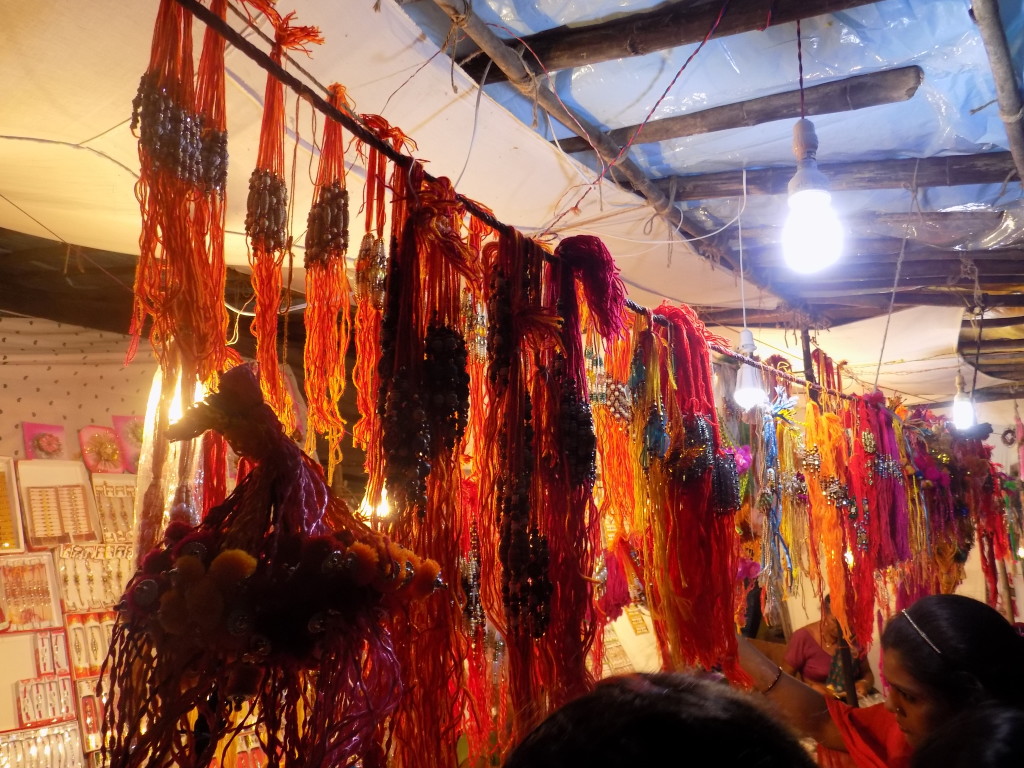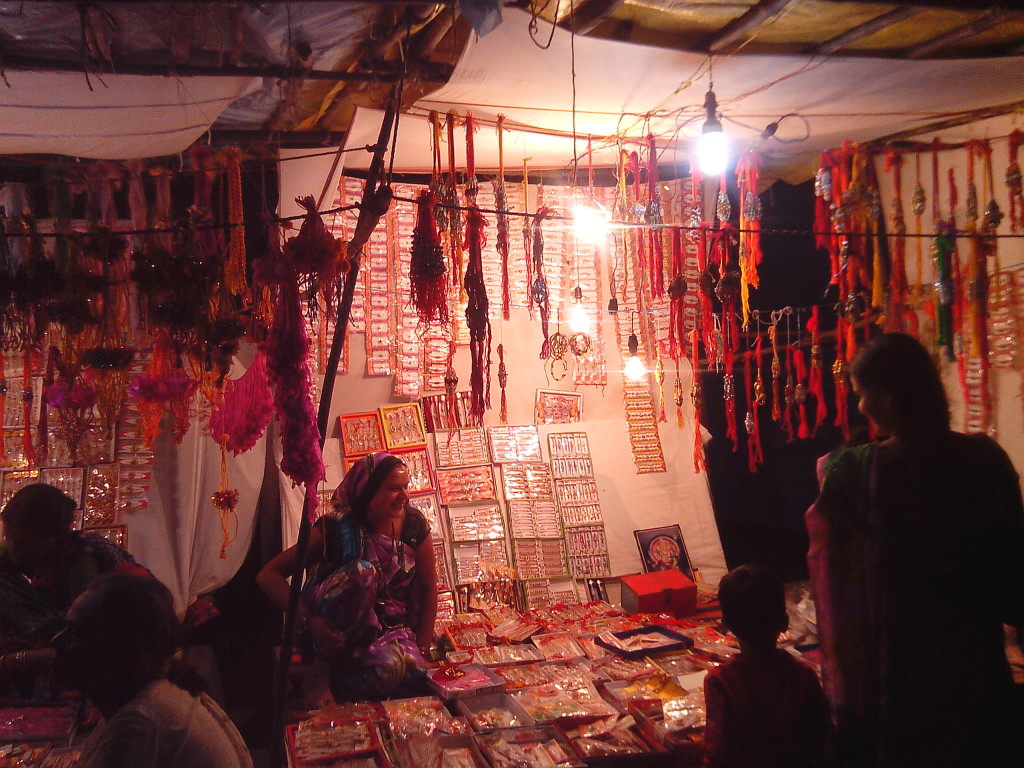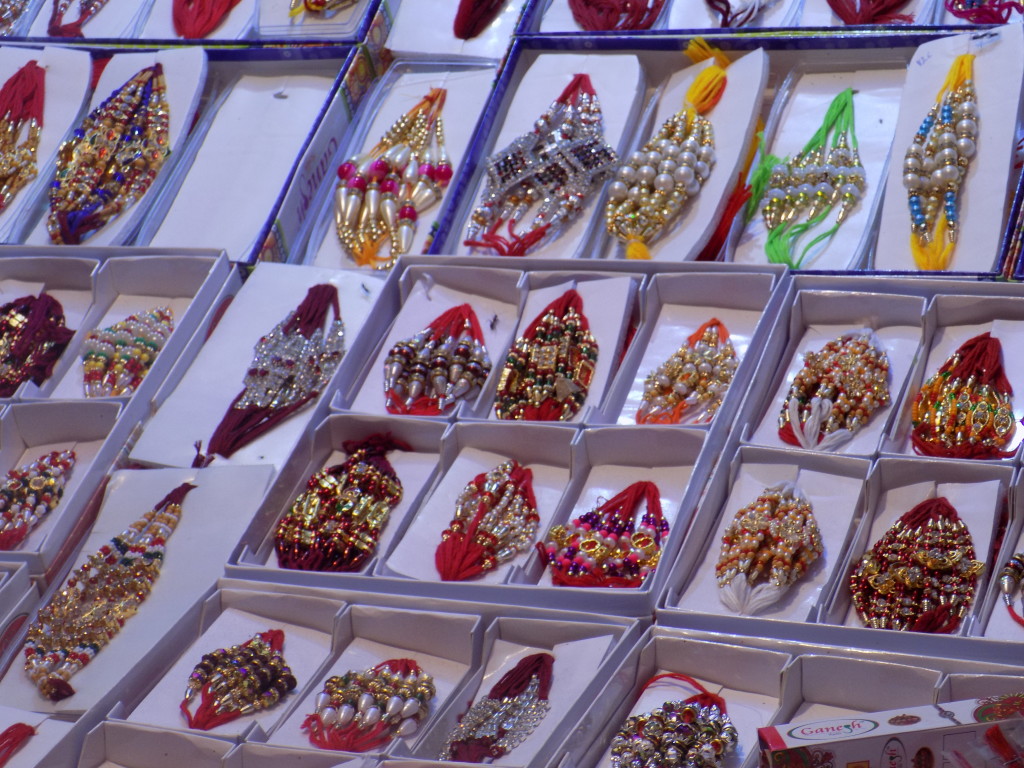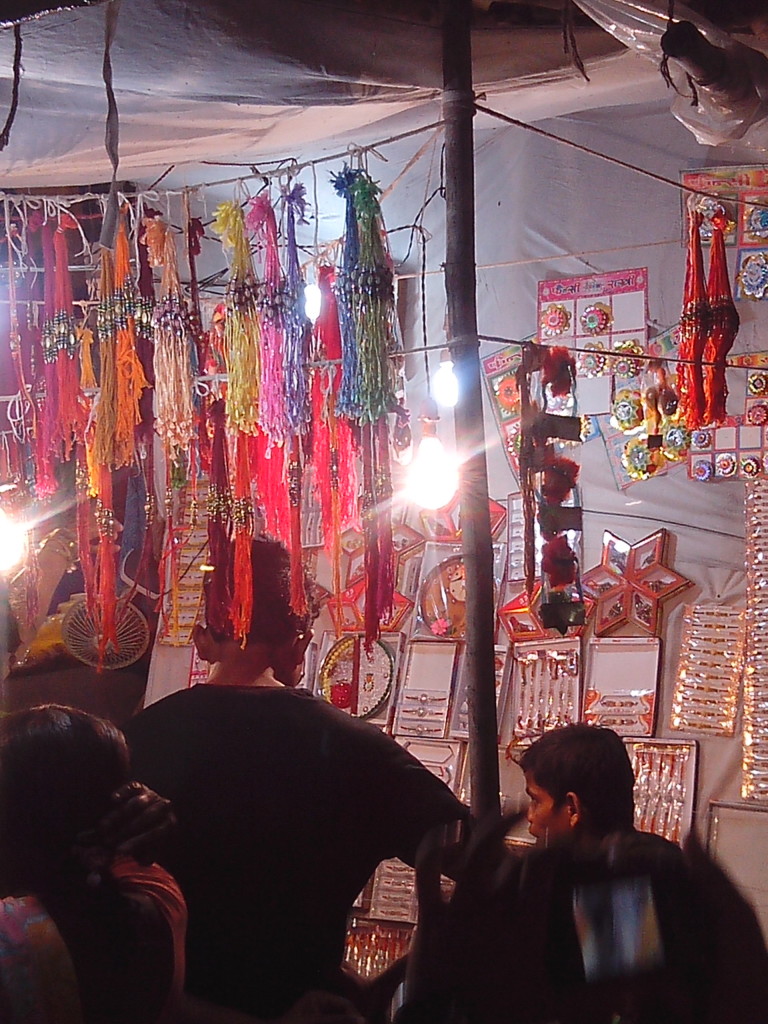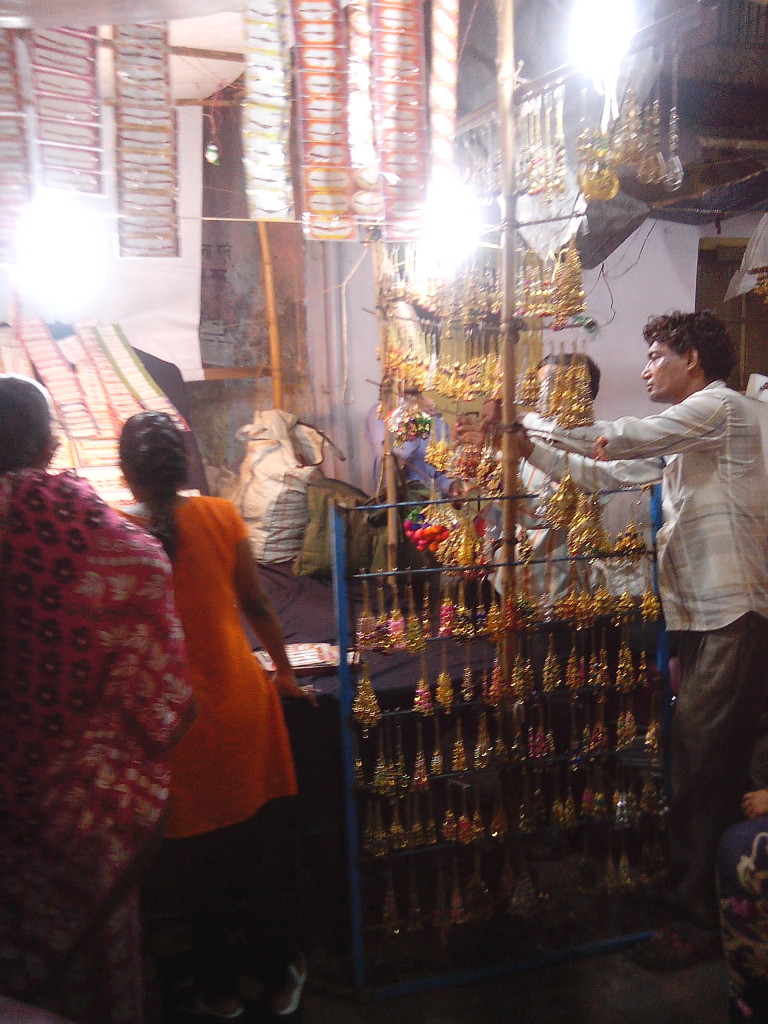It’s the day before yesterday was Raksha Bandhan or Rakhi when specially sisters tie Rakhi on the wrists of their brothers who vow to take care of them in their whole life or vice versa. Even one can tie this Raksha Sutra to someone’s wrist who she thinks will take care and protect her, it could be brother, husband, father, sister or may be someone else too in different parts various ways are adopted to celebrate this festival,it’s a symbiosis of relationships bonded together in this festival.
Prior to this the markets are all decorated with different colorful rachis made out of plastic, sponge, threads and other decorative articles, in Kolkata even rachis are made out of flowers which are biodegradable, fresh and eye soothing even, during the whole month of Sawan or rains one or the god or goddess are worshipped in one form or the other, in this too the night before Rakhi girls put Mehandi or Heena in their palms starting from Indian ti Arabic patterns, it is left to dry out for whole night then its washed off and oil is massaged on the applied area of Heena, later after refreshing oneself new traditional attires are worn and all the possible beautification of oneself brothers sit with a kerchief to cover their heads, after tilak and arti tilak is application of a thin line of vermillion, turmeric with few grains of rice and sandal wood paste mixed in sandal wood oil or clarified butter it has got medicinal value and symbolizes victory when applied on the fore head, then sweets are offered followed by tying Rakhi on the wrist, the brothers are supposed to bless their sisters either by gifting then a token of love either by money or any other gift, if the brother is elderly age wise the girls are supposed to touch their feet for more blessings then all the festivity continues by going to other relatives houses and enjoying all good delicacies, thus the whole day is spent in its full festivity flavor long live the festivities in India to make every day a new festival to look forward.
Here again the interference of Glucose Club comes where it’s a mandatory job of Glucose Club to stress on the social and religious cause of any festivity and to know the social and cultural knowhow behind any festival and to hold on to our own creed and culture and try to enrich it and be proud of those cultures and pass its glamour to the next generation to aid in making the forthcoming society a much more responsible and cultured bunch of people.
Raksha Bandhan is a Hindu festival that celebrates the love and duty between brothers and sisters; the festival is also popularly used to celebrate any brother-sister relationship between men and women who are relatives or biologically unrelated. It is called Rakhi Purnima (Rakhi Pournami) or simply Rakhi or “Rakhri”, in many parts of India. The festival is observed by Hindus, and Jains. Raksha Bandhan is primarily observed in India, Mauritius and major parts of Nepal. It is also celebrated by Hindus in parts of Pakistan, and by some Non Resident Indian people and Non Resident Nepali around the world. It is also celebrated among all people, irrespective of their religion, in West Bengal.
Raksha Bandhan is an ancient festival, dating back six thousand years to the first Aryan civilization – the Indus Valley Civilization. It has many myths and historic legends linked to it. For example, the Rajput queens practised the custom of sending rakhi threads to neighbouring rulers as token of brotherhood. The festival falls on the full moon day (Shravan Poornima) of the Shravan month of the Hindu lunisolar Nepali calendar.
Significance
Raksha Bandhan in Sanskrit literally means “the tie or knot of protection”. The word Raksha means protection, whilst Bandhan is the verb to tie. It is an ancient Hindu festival that ritually celebrates the love and duty between brothers and their sisters. It is one of the several occasions in which family ties are affirmed in India. To many, the festival transcends biological family, brings together men and women across religions, diverse ethnic groups and ritually emphasizes harmony and love. It is observed in the Hindu calendar month of Sravaṇa, and typically falls in August every year.
Prayer
The prayer is a self composed note, or one of many published Rakhi poems and prose. One of the earliest examples of a Rakhi prayer is found in Book V, Chapter V of Vishnu Purana; it is the prayer that Yasoda says while tying a Raksha Bandhan amulet on Krishna’s wrist. An abridged form of the prayer is:
May the lord of all beings protect you,
May the one who creates, preserves and dissolves life protect thee,
May Govinda guard thy head; Kesava, thy neck; Vishnu, thy belly;
the eternal Narayana, thy face, thine arms, thy mind, and faculties of sense;
May all negativity and fears, spirits malignant and unfriendly, flee thee;
May Rishikesa keep you safe in the sky; and Mahidhara, upon earth.
Myths and parables
The scriptures, epics of Hinduism is peppered with stories of Rakhi and Raksha Bandhan. Some of these include:
Indra Dev
According to Hindu scripture Bhavishya Purana, in the war between Gods and demons, Indra – the deity of sky, rains and thunderbolts – was disgraced by the powerful demon King Bali. Indra’s wife Sachi consulted Vishnu, who gave her a bracelet made of cotton thread, calling it holy. Sachi tied the holy thread around Indra wrist, blessed with her prayers for his well being and success. Indra successfully defeated the evil and recovered Amaravati. This story inspired the protective power of holy thread.The story also suggests that the Raksha Bandhan thread in ancient India were amulets, used by women as prayers and to guard men going to war, and that these threads were not limited to sister-brother like relationships.
King Bali and Goddess Laxmi
According to this legend, credited to Hindu scriptures Bhagavata Purana and Vishnu Purana, after Vishnu won the three worlds from the demon King Bali, he was asked by Bali that Vishnu live in his palace, a request Vishnu granted. Vishnu’s wife, Goddess Lakshmi did not like the palace or his new found friendship with Bali, and preferred that her husband and she return to Vaikuntha. So she went to Bali, tied a Rakhi and made him a brother. Bali asked her what gift she desired. Lakshmi asked that Vishnu be freed from the request that he live in Bali’s palace. Bali consented, as well accepted her as his sister.
Santoshi Ma
Ganesh had two sons, Shubh and Labh. On Raksha Bandhan, Ganesh’s sister visited and tied a Rakhi on Ganesh’s wrist. The two boys become frustrated that they have no sister to celebrate Raksha Bandhan with. They ask their father Ganesh for a sister, but to no avail. Finally, saint Narada appears who persuades Ganesh that a daughter will enrich him as well as his sons. Ganesh agreed, and created a daughter named Santoshi Ma by divine flames that emerged from Ganesh’s wives, Rddhi (Amazing) and Siddhi (Perfection). Thereafter, Shubh Labh (literally “Holy Profit”) had a sister named Santoshi Ma (literally “Goddess of Satisfaction”), who loved and protected each other.
Krishna and Draupadi
Krishna considered Draupadi his sister. When Krishna cut his finger while beheading Shishupal, Draupadi immediately tore off a piece of her sari and bandaged his cut. Krishna said that with this loving act, she wrapped him in debt and he would repay each “thread” when the time arrives. Indeed, whenever Draupadi needed Krishna’s protection she fervently prayed for his help, he came to the rescue and gave her unlimited cloth. This is one of the stories of the origin of the Raksha Bandhan festival. In the epic Mahabharat, Draupadi tied a Rakhi to Krishna, while Kunti tied her Rakhi to her grandson Abhimanyu, before the great war.
Yama and the Yamuna
According to another legend, Yama, the god of Death had not visited his sister Yamuna for 12 years. Yamuna, the goddess of Yamuna river, was sad and consulted Ganga, the goddess of Ganga river. Ganga reminded Yama of his sister, upon which Yama visits her. Yamuna was overjoyed to see her brother, and prepared a bounty of food for Yama. The god Yama was delighted, and asked Yamuna what she wanted for gift. She wished that he, her brother should return and see her again soon. Yama was moved by his sister’s love, agreed and to be able to see her again, made river Yamuna immortal. This legend is the basis for a Raksha Bandhan-like festival called Bhai Duj in some parts of India, which also celebrates brother-sister love, but near Diwali.
Historical references
Alexander the Great and King Puru
According to one legendary narrative, when Alexander the Great invaded India in 326 BCE, Roxana (or Roshanak, his wife) sent a sacred thread to Porus, asking him not to harm her husband in battle. In accordance with tradition, Porus, the king of Kaikeya kingdom, gave full respect to the rakhi. On the battlefield, when Porus was about to deliver a final blow to Alexander, he saw the rakhi on his own wrist and restrained himself from attacking Alexander personally.
Rani Karnavati and Emperor Humayun
Another controversial historical account is that of Rani Karnavati of Chittor and Mughal Emperor Humayun, which dates to 1535 CE. When Rani Karnavati, the widowed queen of the king of Chittor, realised that she could not defend against the invasion by the Sultan of Gujarat, Bahadur Shah, she sent a Rakhi to Emperor Humayun. Touched, the Emperor immediately set off with his troops to defend Chittor. Humayun arrived too late, and Bahadur Shah managed to sack the Rani’s fortress. Although contemporary commentators and memoirs do not mention the Rakhi episode and some historians have expressed skepticism about it, it is mentioned in one mid-seventeenth century Rajasthani account.
Rabindranath Tagore and Rakhi
Rabindranath Tagore, the Indian Nobel Laureate for literature, invoked Raksha Bandhan and Rakhi, as concepts to inspire love, respect and a vow of mutual protection between Hindus and Muslims during India’s colonial era. In 1905, the British empire divided Bengal, a province of British India on the basis of religion. Rabindra Nath Tagore arranged a ceremony to celebrate Raksha Bandhan to strengthen the bond of love and togetherness between Hindus and Muslims of Bengal, and urge them to together protest the British empire. He used the idea of Raksha Bandhan to spread the feeling of brotherhood. In 1911, British colonial empire reversed the partition and unified Bengal, a unification that was opposed by Muslims of Bengal. Ultimately, Tagore’s Raksha Bandhan-based appeals were unsuccessful. Bengal not only was split during the colonial era, one part became modern Bangladesh and predominantly Muslim country, the other a largely Hindu Indian state of West Bengal. Rabindranath Tagore started Rakhi Mahotsavas as a symbol of Bengal unity, and as a larger community festival of harmony. In parts of West Bengal, his tradition continues as people tie Rakhis to their neighbors and close friends.
One of Tagore’s poem invoking Rakhi is:
The love in my body and heart
For the earth’s shadow and light
Has stayed over years.
With its cares and its hope it has thrown
A language of its own
Into blue skies.
It lives in my joys and glooms
In the spring night’s buds and blooms
Like a Rakhi-band
On the Future’s hand.
Regional variations
While Raksha Bandhan is celebrated in various parts of South Asia, different regions mark the day in different ways.
Kumaon region
The people of the Kumaon region of Uttarakhand, celebrate Raksha Bandhan with Janopunyu. Along with the sister-brother ritual, men change their janeu (sacred thread). The region also marks the day with Bagwal fair at Devidhura in district Champawat.
West Bengal and Odisha
In the state of West Bengal and Odisha, this day is also called Jhulan Purnima. Prayers and puja of Lord Krishna and Radha are performed there. Sisters tie Rakhi to Brothers and wish immortality. Political Parties, Offices, Friends, Schools to colleges, Street to Palace celebrate this day with a new hope for a good relationship.
Nepal
In Nepal, Raksha Bandhan is celebrated on shravan purnima. It is also called Janaeu Purnima (Janaeu is sacred thread and purnima means full moon). A sacred thread is tied on wrist by senior family members and relatives. Nepalese people enjoy this festival, eating its special food “Kwati”, a soup of sprout of seven different grains.
This day, in Nepal, people change Janai, which is a cord made of cotton threads worn diagonally on the torso, a Vedic ritual. People pay homage to deity Shiva and go on pilgrimage to places such as Gosainkunda, Budhanilkantha, Pashupatinath, Kumbheshwor Temple among others.
Maharashtra
In Maharashtra, the festival of Raksha Bandhan is celebrated as Narali Poornima. Kolis are the fishermen community of the coastal state (Maharashtra). These Kolis offered prayers to Lord Varuna for invoking his blessings. As part of the Rakhi rituals, coconuts were thrown into the sea as offerings to Lord Varuna also they apply vermillion on each other’s foreheads as a symbol of prosperity and joy.
Jammu
In the regions of north India, mostly Jammu, it is a common practice to fly kites on the nearby occasions of Janamashtami and Raksha Bandhan. Its not unusual to see the sky filled with kites of all shapes and sizes, on and around these two dates. The kites start appearing in the sky around, (or sometimes even before) one month before the actual date of the festival. As the date grows closer, the number of kites in the sky increases proportionally. The locals buy kilometres of strong kite string, commonly called as “Gattu Door” in the local language, along with a multitude of kites. They are willing to spend more than a couple thousands to buy the things that the need for this kite flying extravaganza.
Multiculturalism
In contemporary practice, Raksha Bandhan festival has developed into a broader context and a multicultural event. Priests tie rakhis around the wrists of congregation members. Rakhis are often shared between close friends. Women tie rakhis around the wrists of the heads of state, political party or social leaders. Ceremonies are also held to tie Rakhi around the wrists of soldiers. Some Muslims in India view it a secular, multicultural festival.

